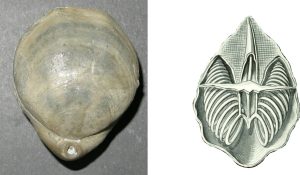
Common brachiopod shell characteristics to help identification
Tray upon tray of brachiopods, molluscs, trilobites, and graptolites, all requiring familiarization before the end of semester – the essence of our early 1970s paleo labs. An odd mix of the fascinating, illuminating, and tedious, that in retrospect provided an excellent grounding for a career that mostly skirted the periphery of paleontology.
This post continues the series on identification of shelly fossils in outcrop or core, preserved as complete specimens or fragments, at least to the taxonomic level of phylum or class.
Brachiopods made their appearance in the Early Cambrian and evolved rapidly through the remainder of the Paleozoic. Modern ‘brachs’ are fully marine filter feeders; the same was probably true of fossil forms. Brachiopods were the most abundant shelly invertebrates throughout the Paleozoic, occupying all manner of marine environments, most abundantly in the photic zone. Burgeoning communities could be found in settings ranging from estuarine – lagoonal to outer shelf and platform and everything in between, nestling in reef crevices or buried in muds. They occupied most of the niches that molluscs now call home.
Brachiopods continued to thrive during the Mesozoic but increasing niche competition by molluscs, augmented by the succession of major extinction events, resulted in fewer species and more restricted distribution. There are currently fewer than 400 extant species, and these tend to live in deeper or colder waters where there is less competition from other invertebrates.
Most of the photographs were taken and generously donated by Annette Lokier, University of Derby (indicated on each image).
Other sources
There are lots… but here are a couple of links to recent texts.
The Paleontological Society provides free access to its Digital Atlas of Ancient Life that contains oodles of explanatory texts, field guides, Apps, and images on the fossil record.
Bringing Fossils to Life: An Introduction to Paleobiology, Donald Prothero. Now in its 3rd Edition.
Brachiopods: origin and early history. 2017. David A. T. Harper, Leonid E. Popov, Lars E. Holmer. Paleontological Association, v. 60, No. 5. Open access.
The Evolution of Brachiopoda. Sandra J. Carlson, 2016. Annual Review of Earth & Planetary Sciences, v. 44, Open Access.
Basic classification
Brachiopods are bivalves. Two broad, more or less informal groups are defined by the mechanism of valve attachment. Formal classification schemas recognise three subphyla, each containing several extinct and extant orders:
- The inarticulates lack a well-defined hinge, have no teeth or sockets, and a shell composed of calcium phosphate that has lower preservation potential than their articulate cousins. This group has a pedicle, a muscular, fleshy stalk-like structure, that in some species provides an attachment to hard substrates. The soft sediment-burrowing genus Lingula is probably the best-known example (it has a pedicle but does not attach to any substrate); recent Lingula seem to have changed little since the Cambrian and are sometimes called ‘living fossils’. The inarticulates are now included in the subphylum Linguliformea.
- Articulate brachiopods have a well-defined hinge that may contain teeth and sockets. Their shells are composed of calcium carbonate. Some orders are attached to substrates by a muscular, stalk-like pedicle. Modern classification schemes define two subphyla – the Craniiformea that possess a hinge but no dentition, and no pedicle; and the Rhynchonelliformea that have all the elements of dentition and a pedicle – this subphylum includes common orders like the Spiriferids, Rhynconellids, and Pentamerids.
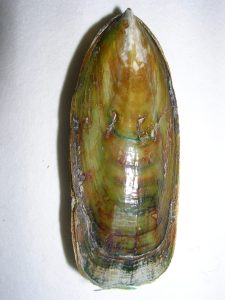
Distinguishing bivalved phyla
The first task when identifying brachiopods is to distinguish them from bivalved pelecypods. Criteria that apply primarily to fossilized forms are tabulated below.
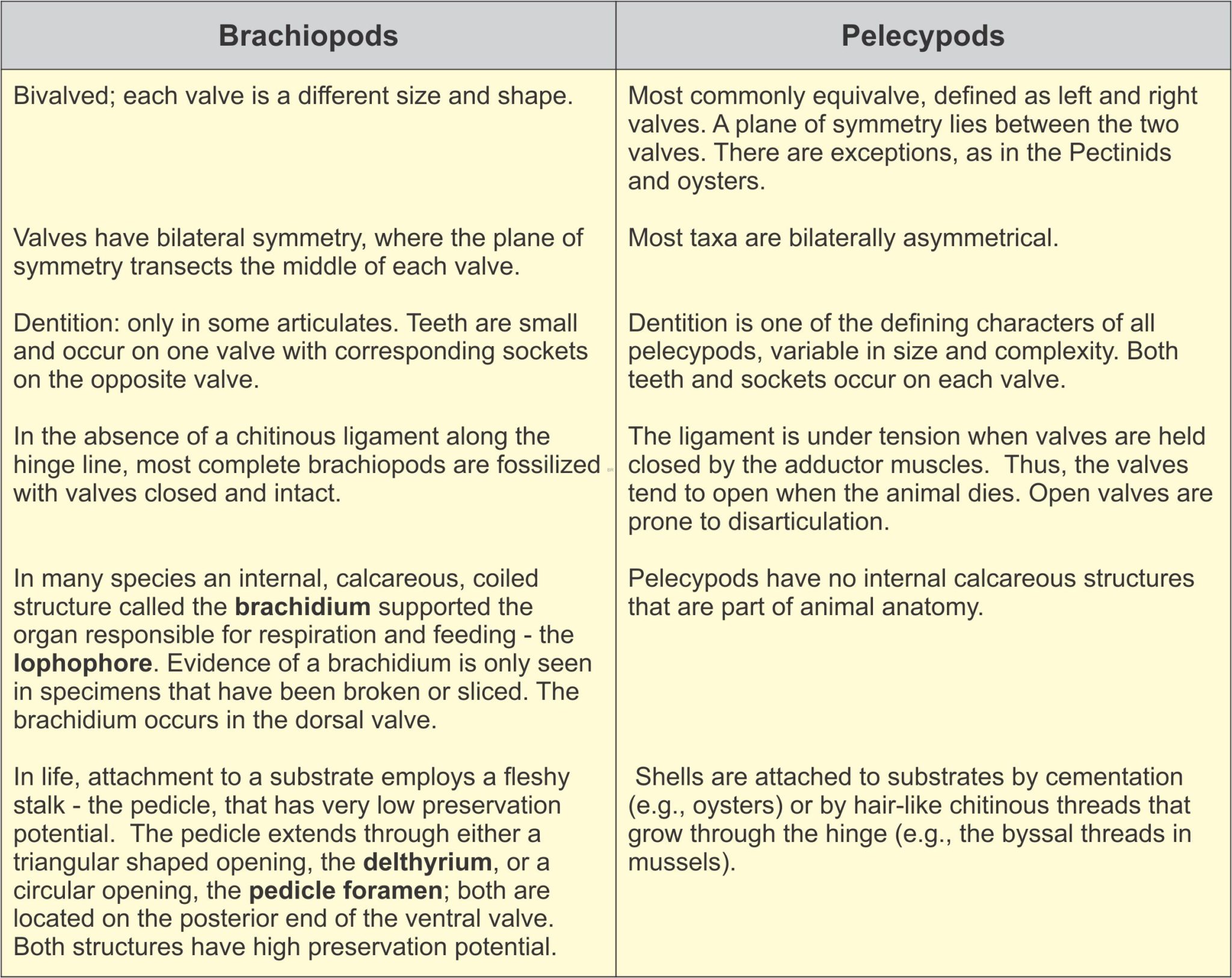
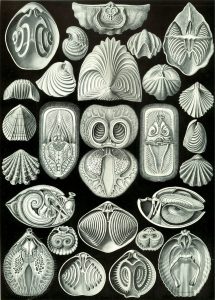
Orientation
The valves in most pelecypods are mirror images and are referred to as left and right valves when observed from the anterior margin. Brachiopod valves are not equal in size or shape. The larger valve is referred to as a ventral or pedicle valve, the smaller as dorsal or the brachial valve. Teeth in the articulates occur on the ventral valve, corresponding sockets on the dorsal valve. The posterior circular opening for the pedicle is the pedicle foramen (always the ventral valve) – this is also the margin where valves are hinged. The opposite margin is anterior. Unlike pelecypods, brachiopods do not need to be oriented in a particular way to classify their valves.
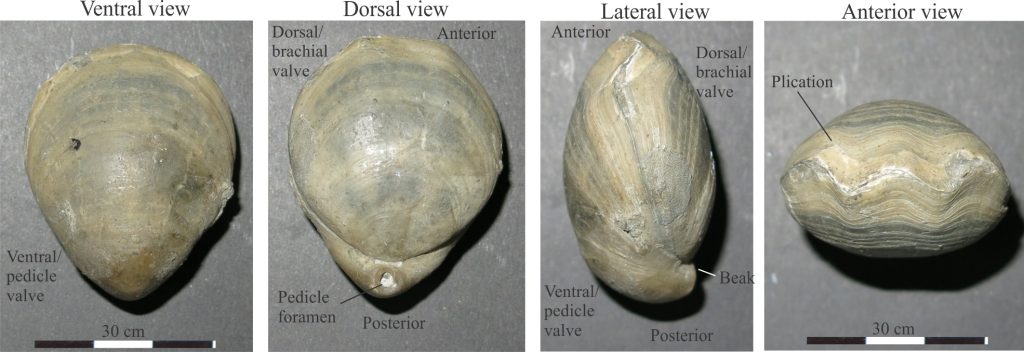
Basic shell shapes
Common pedicle valve – brachial valve combinations are shown below. There are several variations on these shapes.

Morphological attributes of brachiopod shells
Pedicle foramen & delthyrium:
The fleshy, muscular pedicle extends from the posterior end of the ventral valve, through a triangular shaped opening, the delthyrium (example on the left), or a circular opening – the pedicle foramen (example right).
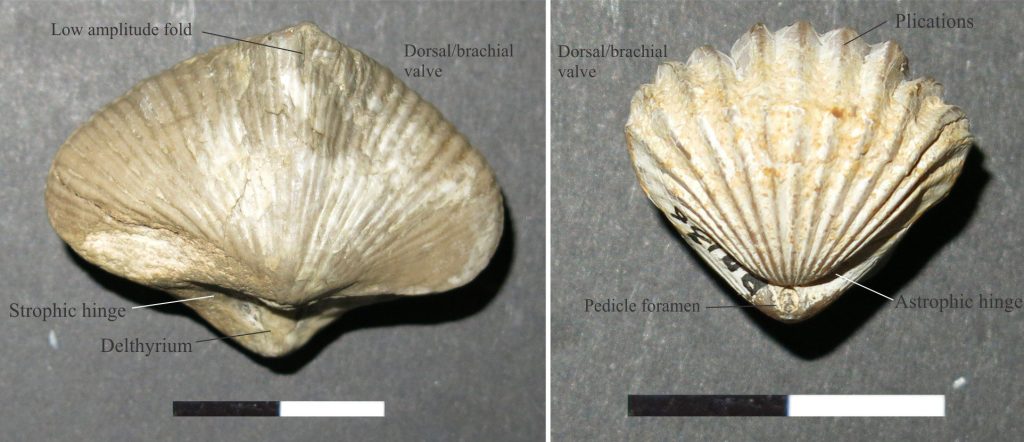
Folds and sulci:
The shells of some orders, like the Rhynchonellids and Spiriferids, contain a distinctive fold (positive, raised, anticline-like structure) in their brachial valve and a corresponding sulcus (depression) in the pedicle valve. The axes of both structures are approximately parallel to the bilateral plane of symmetry.
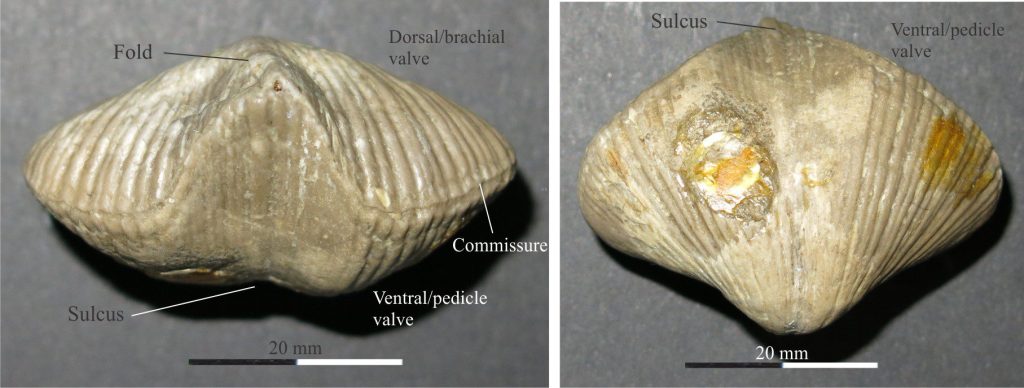
Commissure and plication:
The commissure is the line of contact between the two valves. It may be smooth, or complicated by plications – major fold-like structures on the shell exterior that are also expressed on the shell interior (unlike superficial ornamental ribs); in other words, it is a structure that involves the entire shell thickness. Plicae are commonly manifested as corrugations or zig zag patterns along the commissure.
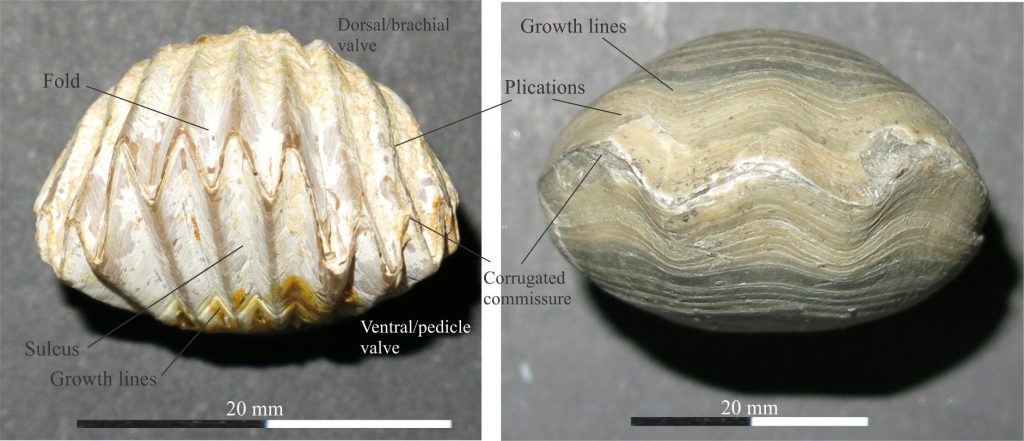
Beak:
The pointy end of both valves, where shell growth was initiated (similar to pelecypods).
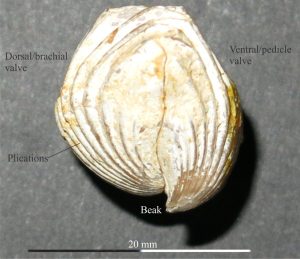
Hinge (and dentition):
The hinge is a narrow zone of articulation between the two valves. It may be straight (strophic hinge) or curved (astrophic hinge). If present, teeth are small knob-like structures on one valve, with corresponding sockets on the other valve – unlike the more complex forms of dentition in pelecypods.
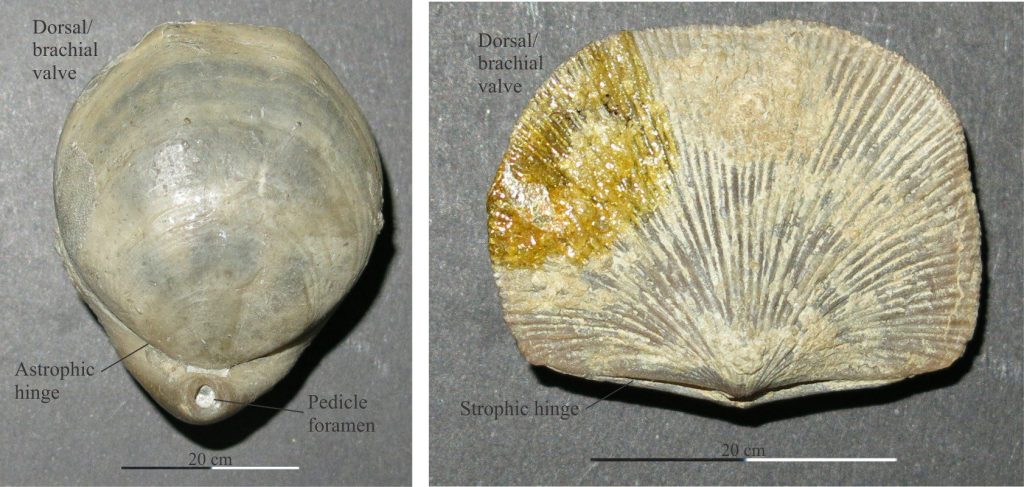
Ribs & Growth lines:
Surface ribs that, unlike plication, are not manifested on the shell interior, radiate from the beak or umbo. Growth lines are usually faint, concentric lines or bands that represent stages of shell growth.
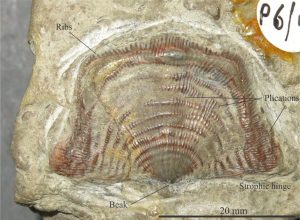
Other posts in this series
Bivalve shell morphology for sedimentologists
Gastropod shell morphology for sedimentologists
Cephalopod morphology for sedimentologists
Trilobite morphology for sedimentologists
Echinoderm morphology for sedimentologists
Carbonates in thin section: Molluscan bioclasts
Mineralogy of carbonates; skeletal grains
Mineralogy of carbonates; non-skeletal grains
Mineralogy of carbonates; lime mud
Mineralogy of carbonates; classification
Mineralogy of carbonates; carbonate factories
Mineralogy of carbonates; basic geochemistry
Mineralogy of carbonates; cements
Mineralogy of carbonates; sea floor diagenesis
Mineralogy of carbonates; Beachrock
Mineralogy of carbonates; deep sea diagenesis
Mineralogy of carbonates; meteoric hydrogeology
Mineralogy of carbonates; Karst
Mineralogy of carbonates; Burial diagenesis
Mineralogy of carbonates; Neomorphism

















